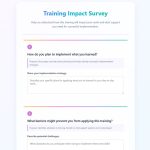Forms help guide your visitors toward taking desired actions. But here’s the question: where should forms go on your website to ensure the highest conversions?
Table of Contents
WordPress is a giant. A legend. A default.
It powers more than 43% of the web — an empire that has stood strong for years. But as we move into a new era, is it still the future? Or Is WordPress dying?
Behind the stable market share and glowing case studies, the data tells a more complicated story. Search interest has plateaued. Market share growth has stalled. And in key regions, faster, simpler platforms are starting to chip away at WordPress’s dominance.
So… what’s really going on?
-
Why are enterprise giants still betting big on WordPress?
-
Why is Shopify gaining ground in unexpected markets?
-
Is Gutenberg the future… or a dead end?
-
And is the golden era of plugin gold rush over?
We dug deep into the search data, market shifts, and inside voices to map what’s actually happening behind the scenes — and where it’s all headed next.
WordPress Isn’t Dead — But Your Old Strategy Might Be
If you think WordPress is invincible, you haven’t been paying attention.
The web isn’t the wild west anymore. It’s a crowded city — and WordPress isn’t the only sheriff in town.
✅ Shopify, Wix, and Squarespace are gobbling up the “easy website” crowd.
✅ Bubble, Webflow, and Framer are building faster, flashier MVPs for startups.
✅ People aren’t just browsing websites anymore — they’re living inside apps, social feeds, and AI chats.
Katie Keith, Founder & CEO at Barn2, sums it up well:
“We have seen the end of the rapid growth that we saw in the past, and can expect slow and steady growth moving forwards.”
It’s not a crisis. It’s a crossroads. WordPress has options to remain relevant — but it’s no longer the go-to solution for everyone.
And here’s the kicker: WordPress’s biggest threat… might actually be WordPress itself.
With endless plugins, bloated themes, and a jungle of conflicting tools, building a site today often feels harder, not easier. As Vikas Singhal, Founder of InstaWP, pointed out:
“WordPress should have native caching, better database optimization, and automatic scaling out of the box. No more relying on 5 different plugins for basic speed improvements.”
Meanwhile, the market is shifting under our feet. Platforms that control the full experience are winning users who don’t want to tinker — they just want results.
As Verdi Heinz, Community Manager at Elementor, put it:
“I’d love to see WordPress focus on enhancing both the user experience and interface (UX/UI), creating a seamless builder experience that rivals the intuitiveness of platforms like Webflow.”
WordPress Isn’t Doomed — It’s Evolving
This doesn’t mean WordPress is doomed.
It means WordPress is evolving.
(And if you want to stay relevant, you need to evolve too.)
The truth?
WordPress still holds aces no one else can match:
-
Total ownership of your site and data.
-
Open-source innovation at scale.
-
A global, passionate community.
-
Infinite flexibility for businesses that outgrow walled gardens.
As Jonathan Wold, Co-founder of Guildenberg, stated:
“WordPress has stayed in power because of the size of the ecosystem.”
It’s the sheer size and diversity of WordPress’s ecosystem — from plugins to themes, and everything in between — that’s kept it at the top for so long.
But with the landscape shifting, the question remains: Will you evolve with the ecosystem to lead the next chapter?
Or will you be left behind, stuck building sites the old way… for an audience that’s already moved on?
👉 Download Our Exclusive e-Book
Inside, you’ll get real data, fresh insights, and a blunt look at the shifts no one else is talking about. Because in the new era of the web, fast beats slow — and adaptation beats nostalgia.








